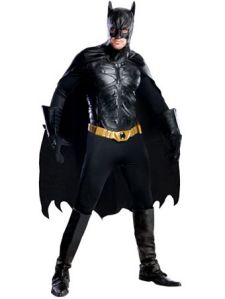A door swung open, sending a blast of cold air and a flapping sound through the java joint. Slowly, I lifted my head. A black-clad, caped figure with a pointy-eared hood stretched over his face flapped into my office. Batman. Sure, why not? This was Hollywood, an area that had earned the sobriquet Hollyweird and wasn’t about to give it up. We were a few miles from the Chinese Theatre where you expect to see caped crusaders flocking like pigeons to the Piazza San Marco. Lately the cops had been cracking down on costumed characters for aggressive begging, scattering Scissorhands and Scooby-Doos in search of safer ground.
“Who wants to know?”
Blue eyes bored through the slits in his mask. “I can pay cash,” he said, flicking some crumpled but nicely denominated bills onto the table. I smoothed them on the edge of the table and slipped them away.
“Okay, Batman. Have a seat. What can I do for you?”
He told me. Was this guy batty? I wondered. But my wallet bulged with Benjamins so I gave him the information he was looking for.
He bounded out, whipping his cape out of the way of the slamming door.
Batting an eye, batty, bats (in the belfry and the ballpark) – were they related? I checked the OED Online.
Bat, meaning a stick or cudgel, may be a merger of two words. The word bat appeared in Middle English apparently from Old French batte (from battre, ultimately from Latin battuere, ‘to beat’). Some etymologists reconstructed a hypothetical Old English word, *bat, believing it to be of Celtic origin. But others think the Old English word may be borrowed from “a Romance language” and so it would stem from the same Latin source, entering the language twice.
To bat a ball is one thing. That verb derives from the instrument of the same name. Bat as in “batting an eye” also came from battuere but it took the long way round. Bat in that sense came from bate ‘to beat back or blunt the edge of’ or ‘to lessen in force or intensity,’ now heard almost exclusively in the expression “to wait with bated breath.” Bate is a shortening of abate ‘to put an end to,’ which comes from Anglo-Norman abater, ‘to knock down, raze, dismantle,’ ultimately from Latin ab- ‘away’ + battuere, ‘to beat’
Okay, I’m beat. More on bats and batting later.


Dear Lexie: A question popped into my mind recently (yes, there’s lots of empty space up there in my brain) and I wondered if you can help answer it for me. Why do European languages use alphabets that require the use of capital letters at the beginning of sentences, for certain (or in the case of German, all) nouns? I don’t believe that this is a requirement of the Korean alphabet and doubt that Chinese or Japanese characters have upper and lower case versions. What’s the scoop?
Dana Barraclough
>________________________________ >From: Lexie Kahn: Word Snooper >To: dfbarraclough@yahoo.com >Sent: Thursday, January 17, 2013 9:18 PM >Subject: [New post] Holy Hollywood! Has Batman Gone Batty? > >WordSnooper.com posted: “A door swung open, sending a blast of cold air and a flapping sound through the java joint. Slowly, I lifted my head. A black-clad, caped figure with a pointy-eared hood stretched over his face flapped into my office. Batman. Sure, why not? This was Holly” >
Hi, Dana,
Anonymous got a slap on the wrist for not citing sources in this Wikipedia article on letter case, but from what I remember from my history of the book course back in the last millennium, she is correct: http://en.wikipedia.org/wiki/Letter_case#History. I was not familiar with the terms “camel case,” “Pascal case” or “Bumpy case,” but I have heard a capital letter within a word referred to as an “intercap.”
Chinese is written in ideograms (characters representing an idea or concept rather than sounds). Since the ideograms represent entire words there’s not really an equivalent of capitalizing the first letter. There are different script styles, but usually one would be used consistently throughout a document.
Japanese uses ideograms based on Chinese characters for content words, plus a native syllabary (each symbol representing a syllable — like ka, ke, ki, ko or ku — rather than a single phoneme) for grammatical “function” words. Foreign words are spelled out with a different syllabary.
I thought Korean did the same, but I just learned this: http://home.vicnet.net.au/~ozideas/writkor.htm
Thanks for educating me about Hangul.
Pingback: Lexie Reemerges from the Etymological Underground | Lexie Kahn: Word Snooper